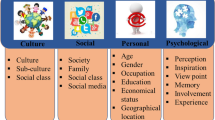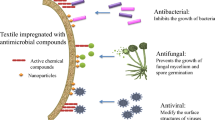Abstract
The technical textiles industry in the USA and the EU is growing. As we advance into the knowledge age, objects and material technology will disappear into our material environment, turning unintelligent objects into active and intelligent participants in our lives. As much of our environment is made up from textile materials, they will be the targets of smart engineering. The future of smart textiles will rely on the convergence of electrochemistry and textiles in order to process electronic polymers into fibres and fabrics. The integration of smart functionality into clothing and other textile products will radically change the culture surrounding these products, fundamentally altering people’s relationships with them and the way they use them. Smart functionality will also have an impact on the way products are designed and the materials developed.

Similar content being viewed by others
Notes
Since 1974, world trade in textiles and garments has been governed by the Multi-Fibre Arrangement. This provided the basis on which industrialised countries have been able to restrict imports from developing countries. It will expire at the end of 2004.
Sense of touch.
References
Marzano S, Arts E (2003) The new everyday: views on ambient intelligence. 010 Publishers, Rotterdam, The Netherlands
Macdonald N (2003) About: interaction design. The Design Council paper. http://www.designcouncil.org.uk
Gilmore JH, Pine BJ II (1999) The experience economy. Harvard Business School Press, Harvard
Gershenfield N (1999) When things start to think. Hodder and Stoughton, London
Selker T, Burleson W (2000) Context-aware design and interaction in computer systems. IBM Syst J 39(3/4):880–891
Mattelmäki T, Keinonen T (2001) Design for brawling—exploring emotional issues for concept design. In: Proceedings of the 1st international conference on affective human factors design (CAHD 2001), Singapore, June 2001. Asean Academic Press, London
Raffle H (2003) Super Cilia Skin: an interactive membrane. In: Proceedings of the conference on computer human interaction (CHI 2003), Ft. Lauderdale, Florida, April 2003
Ishii H, Chang A, O’Modhrain S, Jacob R, Gunther E (2002) ComTouch: design of a vibrotactile communication device. In: Proceedings of the symposium on designing interactive systems: processes, practices, methods, and techniques (DIS 2002), London, June 2002
Darwin C (1965) The expression of the emotions in man and animals. University of Chicago Press, Chicago
Entwistle J (2000) The fashioned body: fashion, dress, and modern social theory. Polity Press, Cambridge
Ark WS (1999) A look at human interaction with pervasive computers. IBM Syst J 38(4):504–507
Bernard (1996) Fashion as communication. Routledge, London
Douglas M (1971) Do dogs laugh? A cross-cultural approach to body symbolism. J Psychosom Res 15:387–390
Venture Development Corporation, USA (2003) Smart fabrics and interactive textiles: a global market opportunity assessment
Author information
Authors and Affiliations
Corresponding author
Additional information
Published in Wearable electronics and photonics, Xiaoming Tao (ed), published by Woodhead Publishing Limited, Cambridge, UK.
Copyright belongs to Woodhead Publishing Limited.
The full version of this will be published in Wearable electronics and photonics, Xiaoming Tao (ed), published by Woodhead Publishing Limited, Cambridge, UK
Bibliography
Bibliography
Central Saint Martins College of Art and Design, London. http://www.csm.linst.ac.uk
Xerox Palo Alto Research Center (PARC), Palo Alto. http://www.parc.xerox.com
The Disappearing Computer (DC) Initiative, European Union. http://www.disappearing-computer.net
IBM Almaden Research Centre, San Jose. http://www.almaden.ibm.com
Media Lab, MIT, Boston. http://www.media.mit.edu
Smart Paper by Gyricon, Ann Arbor. http://www.gyriconmedia.com/SmartPaper.asp
Interaction Design Department, Royal College of Art, London. http://www.interaction.rca.ac.uk/
Interactive Institute, Ivrea. http://www.interaction-ivrea.it/en/index.asp
Things That Think Group, MIT, Boston. http://ttt.media.mit.edu
Sony Computer Science Laboratory, Tokyo. http://www.csl.sony.co.jp
Maslow AH (1968) Toward a psychology of being. D. Van Nostrand , New York
EPSRC Network smart textiles for intelligent products. CSM, London. http://www.smartextiles.net
Kaiser SB (1997) The social psychology of clothing: symbolic appearances in context. Fairchild Publications, New York
Philippe F, Schacher L, Adolphe DC (2003) The sensory panel applied to textile goods: a new marketing tool. J Fashion Marketing Manag 7(3):235–248
Department of Kansei Engineering, Faculty of Textile Science and Technology, Shinshu University, Japan. http://www.tex.shinshu-u.ac.jp/faculties/kansei/kansei_e.html
Polhemus T (ed) (1978) Social aspects of the human body. Penguin, London
Hickson ML III, Stacks DW, Moore N-J (2004) Nonverbal communication studies and applications, 4th edn. Roxbury, Los Angeles
Valdez P, Mehrabian A (1994) Effects of color on emotions. J Exp Psychol 123(4):394–409
vCard, Internet Mail Consortium, Santa Cruz. http://www.imc.org/pdi
Randell C, Baurley S, Chalmers M, Müller H (2004) Textile tools for wearable computing. In: Proceedings of the 1st international forum on applied wearable computing (IFAWC 2004), Bremen, Germany, March 2004
Plastic Logic, Cambridge. http://www.plasticlogic.co.uk
Cavendish Laboratory, Cambridge University, Cambridge. http://www.phy.cam.ac.uk
School of Materials Science and Engineering, Clemson University, Clemson. http://mse.clemson.edu
Rights and permissions
About this article
Cite this article
Baurley, S. Interactive and experiential design in smart textile products and applications. Pers Ubiquit Comput 8, 274–281 (2004). https://doi.org/10.1007/s00779-004-0288-5
Received:
Accepted:
Published:
Issue Date:
DOI: https://doi.org/10.1007/s00779-004-0288-5




